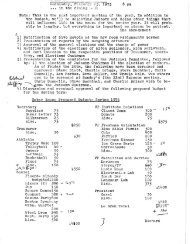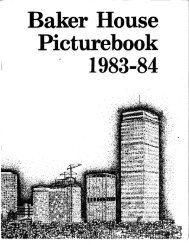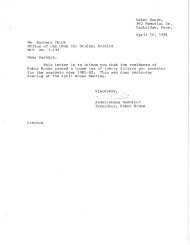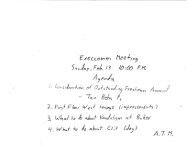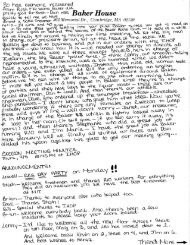The History of Dining at MIT - Mit81.com
The History of Dining at MIT - Mit81.com
The History of Dining at MIT - Mit81.com
- No tags were found...
Create successful ePaper yourself
Turn your PDF publications into a flip-book with our unique Google optimized e-Paper software.
<strong>The</strong> <strong>History</strong> <strong>of</strong> <strong>Dining</strong> <strong>at</strong> <strong>MIT</strong>Michael Plasmeier 3/31/2010<strong>The</strong> history <strong>of</strong> dining <strong>at</strong> <strong>MIT</strong>’s Cambridge campus goes back to when the new campus wasbeing planned. When the new campus was first being planned in 1913, a commission was setup to plan out student life on the new campus. 1 <strong>MIT</strong> wanted to build two separ<strong>at</strong>e facilities:a large dining commons and the Walker Memorial, a gentleman’s club. 2 <strong>The</strong> dining facilitieswere to be built a short walk away from the Walker Memorial and be connected by awalkway. <strong>The</strong> facility was to be large and centralized, in order to save money and bringpeople together. 3 This was unlike some other schools, such as Harvard, where each Househad its own dining hall. <strong>The</strong>re should have been a large dining room, as well as smaller roomsfor groups, such as fr<strong>at</strong>ernities, to e<strong>at</strong> together. It was thought th<strong>at</strong> students would generallye<strong>at</strong> lunch together, while e<strong>at</strong>ing with one <strong>of</strong> the small groups they were part <strong>of</strong> for dinner. Inadditions, there should have been a lunch counter as well as a place for students to he<strong>at</strong>meals th<strong>at</strong> they brought from home. Even <strong>at</strong> this early stage the planners realized th<strong>at</strong> <strong>MIT</strong>presented “difficult and puzzling problems” such th<strong>at</strong> plans implemented <strong>at</strong> other universitiesmay not work <strong>at</strong> <strong>MIT</strong>.Meanwhile, the Walker Memorial was to be like a gentleman’s club, except “a man <strong>of</strong> limitedmeans” would be able to “particip<strong>at</strong>e in the real privileges <strong>of</strong> Institute life.” It was to be1 Designing <strong>MIT</strong>: Bosworth’s New Tech p1082 Letter by H. W. Tyler ’84 in Technology Review 1913 p 73 Letter by Frank L. Locke ’86 in Technology Review 1913 p 34
named after Fransis Amos Walker, the third president <strong>of</strong> <strong>MIT</strong> who had championed student lifefrom 1881-1897. In addition, the faculty pushed for a Grill or a nicer dining hall where theycould bring guests. 4 However, budget cuts combined the dining room and the gymnasium intothe Walker Memorial. Throughout history, the Walker Memorial had Morss Hall a full servicefacility on the ground floor and the Pritchett Grill on the second floor which was open longerhours and served snacks such as burgers. Both facilities were open as l<strong>at</strong>e as 1999 and thePritchett Grill finally closed in 1997. 56<strong>The</strong> facility was to be economical, and break even. 7 However, should the oper<strong>at</strong>ions cost maygo over income, the deficit should be made up by alumni don<strong>at</strong>ions, and not be taken fromthe endowment. 8 This shows th<strong>at</strong> <strong>at</strong> the very earliest days the Institute wanted the diningfacilities to break even. This has been the case more or less for the history <strong>of</strong> the system. Atpoints in time, the administr<strong>at</strong>ion increased the system to improve student life. For a shorttime during the 1990s they <strong>of</strong>fered the pr<strong>of</strong>its <strong>of</strong> the system to the highest bidder.4 Letter by Alfred E. Burton in Technology Review 1913 p 115 http://web.mit.edu/vrtour/n3_index.html6 <strong>The</strong> Tech V 127 N 167 Letter by Frank L. Locke ’86 in Technology Review 1913 p 348 Letter by H. W. Tyler ’84 in Technology Review 1913 p 7
<strong>The</strong> Walker Memorial was the only choice for dining until Senior House, today Baker Housewas opened in 1949. 9 <strong>Dining</strong> in Baker allevi<strong>at</strong>ed the crowding in Walker. In addition, Bakerwas the first dorm on west campus and the Walker Memorial was far away. Baker was alsoseen as significantly more luxurious than other dorms <strong>at</strong> the time <strong>at</strong> <strong>MIT</strong>. <strong>The</strong> undergradu<strong>at</strong>edorms th<strong>at</strong> existed were either built with <strong>MIT</strong>’s campus (East Campus and Senior House), orwere temporary barracks built for the war. When the Baker opened, it brought with it amand<strong>at</strong>ory meal plan th<strong>at</strong> required th<strong>at</strong> Baker residents to buy 15 meals a week from Baker’sdining hall <strong>at</strong> $10/week. From the Tech’s editorial page there were no complaints about themand<strong>at</strong>ory plan, only complaints th<strong>at</strong> the institute wanted to make a 3% pr<strong>of</strong>it onconstruction costs from the students in the rent. 10<strong>The</strong> 1956 Ryer Commission report was a landmark report in student life and it set the stagefor house dining and all <strong>of</strong> the subsequent trouble. 11 It recommended th<strong>at</strong> west campusbecome the center <strong>of</strong> student life. A student center was to be built on west campus. Inaddition, it recommended th<strong>at</strong> each dorm have a dining hall, as well as simple kitchenfacilities on each floor. Dorms th<strong>at</strong> were temporarily without dining halls should not be on amand<strong>at</strong>ory meal plan because students were not interacting in Walker. <strong>The</strong> Ryer reportwanted to cre<strong>at</strong>e houses <strong>of</strong> no more than 200 students, each with its own dining hall. Th<strong>at</strong>9 <strong>The</strong> Tech V 69 N 1610 <strong>The</strong> Tech V 69 N 1511 <strong>The</strong> Tech V 76 N 30 starting <strong>at</strong> page 5 <strong>at</strong> http://tech.mit.edu/V76/PDF/N29.pdf
meant th<strong>at</strong> it proposed th<strong>at</strong> Burton House be split in two and th<strong>at</strong> one dining hall should bebuilt for each House. 12Only one dining hall was added a few years l<strong>at</strong>er to newly split Burton-Conner House for “thesocial benefit <strong>of</strong> communal dining.” 13 <strong>The</strong> students were generally pleased th<strong>at</strong> the newdining hall would be built. <strong>The</strong> other facilities suffered from overcrowding and the residentswere looking forward to the additional lounge space. <strong>The</strong> students were more or less pleasedwith the new facility when it opened in 1961; however they complained th<strong>at</strong> the facility wasnot ready to go on day 1. 14 Instead, dinner had to be served early because lights had not yetbeen installed. Elsewhere on campus, students generally resented the implement<strong>at</strong>ion <strong>of</strong>mand<strong>at</strong>ory Commons. 15<strong>The</strong> Ryer report was not economically sound. It recommended removing many beds fromeach house, and unnecessary renov<strong>at</strong>ions to split Burton House. House dining halls are bytheir n<strong>at</strong>ure more expensive. <strong>MIT</strong> students have always been price sensitive, even if they hadfinancial aid. In addition, they cre<strong>at</strong>ed competition between the house dining halls, centralfacilities in the Student Center and Walker, and kitchens where students could cook forthemselves. Lastly, the Ryer report recommended the removal <strong>of</strong> mand<strong>at</strong>ory meal plan for12 <strong>The</strong> Tech V 76 N 30 starting <strong>at</strong> page 5 <strong>at</strong> http://tech.mit.edu/V76/PDF/N29.pdf13 <strong>The</strong> Tech V 76 N 3114 <strong>The</strong> Tech V 81 N 1715 <strong>The</strong> Tech V 90 N45
student life reasons without considering the effect on the bottom line <strong>of</strong> the dining facilities.Although the authors <strong>of</strong> the Ryer report may not have known, they were trading break-evenedict for an improvement in student life.In October <strong>of</strong> 1965 the Student Center opened. 1617 <strong>The</strong> facility further tried to allevi<strong>at</strong>ecrowding in Walker by proving a facility in west campus. However, Robert Holden <strong>of</strong> theadministr<strong>at</strong>ion wanted the facility to not be just a dining hall. 18 He wanted the facility to“merchandize” in order to cre<strong>at</strong>e demand for the students to use it. It would have a nice grillroom, Twenty Chimneys, which would have sit down service. <strong>The</strong> grill should compare withrestaurants in Boston. Lastly, the facility should break even. However, from the verybeginning the facility had trouble turning a pr<strong>of</strong>it. 19 This was despite 80% particip<strong>at</strong>ion, onpar with peer schools such as Harvard. 20 Reports from two years after the Student Center16 <strong>The</strong> Tech V 85 N 1817 <strong>The</strong> Tech V 85 N 1718 Letter from Robert H. Holden Letter Jan 10 1968. Institute Archives AC 115 Box 9 folder“Student Center: <strong>Dining</strong> Services, 1967-1968”19 <strong>The</strong> Tech V 87 N 2920 Letter Feb 21 1967 Institute Archives AC 115 Box 9 folder “Student Center: <strong>Dining</strong>Services, 1967-1968”
opened showed th<strong>at</strong> the facility was also struggling with limited equipment and staffing.Soon after it opened, Twenty Chimneys was turned into a student-run l<strong>at</strong>e night option. 21In 1957, Stouffer’s began managing the 2 dining facilities in the Walker Memorial. 22 <strong>The</strong> firmwas in control <strong>of</strong> planning the menu and ordering food. <strong>The</strong> servers would still be employedby <strong>MIT</strong>. <strong>The</strong> firm was chosen because they were the only ones doing research into food,especially frozen food. This was Stouffer’s first contract for college food service. 23 <strong>The</strong>reaction to the firm was mixed. In 1966, a student opinion in <strong>The</strong> Tech, a student questionedwhy <strong>MIT</strong> used Stouffer’s as an external contractor. 24 <strong>The</strong> student thought th<strong>at</strong> it would havebeen better to bring in external vendors from the community to campus. However, this wasnot uniform. In 1957, students in Baker boycotted their dining hall in order to get Stouffer’sto manage their dining hall. 25 230 students skipped dinner in Baker and went to Walkerinstead where they believed the food was better. <strong>The</strong> boycotted a second night when thecafeteria planned to rehe<strong>at</strong> the food th<strong>at</strong> they were originally supposed to serve. When the21 Letter from D. K. Cantley Institute Archives AC 115 Box 9 folder “Student Center: <strong>Dining</strong>Services, 1967-1968”22 <strong>The</strong> Tech V 77 N 123 Letter by Robert J Holden Associ<strong>at</strong>e Director <strong>of</strong> Student Affairs April 5, 1963 InstituteArchives AC 115 Box 9 folder “Student Center: <strong>Dining</strong> Services, 1967-1968”24 <strong>The</strong> Tech V 86 N 1025 <strong>The</strong> Tech V 77 N 8
administr<strong>at</strong>ion was planning the Student Center, they were hesitant to give the contract toStouffer’s due to their poor reput<strong>at</strong>ion on campus. 26 <strong>The</strong>y wanted a different oper<strong>at</strong>or tomake the Student Center seem special and keep competition. However, this discontent wasnot solely when a contractor was used. Students complained about the low quality <strong>of</strong> thefood and the high prices in Walker in 1946. 27Mand<strong>at</strong>ory Commons from the Ryer Report continued until 1971. 28 <strong>The</strong> 1963 Committee onStudent Environment strongly endorsed mand<strong>at</strong>ory and the construction <strong>of</strong> dining halls in newdorms. <strong>The</strong> reasoning given by the administr<strong>at</strong>ion were good health and indirect educ<strong>at</strong>ionaladvantages, although the students thought th<strong>at</strong> finances was the real reason. <strong>The</strong>administr<strong>at</strong>ion told the students who boycotted against mand<strong>at</strong>ory Commons to move to adorm without Commons if they did not like the situ<strong>at</strong>ion. <strong>MIT</strong> did not want everyone tosubsidize the dining service, only the people who used it. In 1969, the administr<strong>at</strong>ion letstudents pay $145 to receive a discount on a la carte items. However, the students pointedout th<strong>at</strong> even if you fully used the plan you would still lose money. Still the students foughtmand<strong>at</strong>ory Commons. 80% <strong>of</strong> McCormick residents said th<strong>at</strong> they favored closing their dininghall in return for voluntary Commons.26 Letter by Robert J Holden Associ<strong>at</strong>e Director <strong>of</strong> Student Affairs April 5, 1963 InstituteArchives AC 115 Box 9 folder “Student Center: <strong>Dining</strong> Services, 1967-1968”27 <strong>The</strong> Tech V 76 N 5228 <strong>The</strong> Tech V 90 N 45
In 1971, mand<strong>at</strong>ory Commons was dropped. 29 <strong>MIT</strong> implemented a small yearly fee forresidents in dorms with dining halls and an additional penalty for not choosing Commons. 30<strong>The</strong> Institute was losing money for several years on a mand<strong>at</strong>ory Commons plan and it thoughtit could make more money with voluntary Commons and the new fee. However, it did notwork out th<strong>at</strong> way <strong>at</strong> all. In substituent years, the system lost money because only 750people signed up for a voluntary meal plan. As a result, the Institute cut the dining room inMcCormick to lunch only in 1972 and closed down the dining room in Ashdown completely. In1974, <strong>MIT</strong> dropped Stouffer’s and started managing the dining halls themselves. <strong>MIT</strong>’smanagement style was more decentralized than Stouffer’s highly centralized style. However,the students did not notice many changes.In 1980, the Committee on Campus <strong>Dining</strong> restarted mand<strong>at</strong>ory Commons. 31 <strong>The</strong> plan wash<strong>at</strong>ed by students, who protested it strongly. 32 In the negoti<strong>at</strong>ions the plan was subsequentlyexpanded to also include a la carte items, seconds, and Kosher options and make it moreflexible. <strong>The</strong> plan wanted dining as a focal point <strong>of</strong> community. It also sought to crack downon unauthorized hot pl<strong>at</strong>e usage and renov<strong>at</strong>e over crowded student kitchens. It reopenedthe dining halls in Burton, Ashdown, and McCormick. Before the plan, about 40% <strong>of</strong> all29 <strong>The</strong> Tech V 94 N 2630 <strong>The</strong> Tech V 91 N 131 1980 Committee on <strong>Dining</strong> Report Institute Archives AC 19 Box 832 <strong>The</strong> Tech V 99 N 25
students opted in to the Commons system when it was voluntary. 33 Particip<strong>at</strong>ion r<strong>at</strong>es inBaker were 70%. At Lobdell and Morss half <strong>of</strong> the customers <strong>at</strong> lunch were not students.However, only 25% <strong>of</strong> the <strong>MIT</strong> community used the dining services.It was <strong>at</strong> this time th<strong>at</strong> the Institute ran the most extensive dining system in its history, andhad an extremely complex meal plan to maximize flexibility. 34 Students received a 19 pagebrochure explaining the options. <strong>The</strong> administr<strong>at</strong>ion even said th<strong>at</strong> “in actual practice thesystem will be easy to use.” 35 <strong>The</strong> dining halls in Baker, McCormick, MacGregor, and wh<strong>at</strong>would be called Next House were called “Commons” and served food <strong>at</strong> a single price forgoing through the line. Lobdell food court in the Str<strong>at</strong>ton Student Center was also open for ala carte on weekdays and Commons on weekends. Twenty Chimneys, was open as a grill andsnack bar until midnight. In the Waker Memorial, Morss Hall served Commons on weekdaysand the Pritchett Grill upstairs served snacks weekdays until midnight.Residents <strong>of</strong> the dorms with dining halls were forced to purchase a minimum amount <strong>of</strong>meals. Freshmen had to purchase $559 worth <strong>of</strong> meals per term with the amount decliningeach year. Dinner in the Commons cost 3 points, lunch 2 points, and breakfast cost 1 point.<strong>The</strong> first 160 points th<strong>at</strong> one purchased cost $2.03 and after th<strong>at</strong> each point cost $1.17. <strong>The</strong>meals in the a la carte cost their listed price. <strong>The</strong>re was also a provision to buy the rights togo through the line for seconds for the entire term.33 Draft 2 <strong>of</strong> Report Institute Archives AC 19 Box 834 <strong>MIT</strong> Food Service Guide 1982-198335 Plan marketing m<strong>at</strong>erials Institute Archives AC 19 Box 8
A report from the Arthur D. Little consultancy said th<strong>at</strong> <strong>MIT</strong> had a basic responsibility toprovide reasonably priced food service as part <strong>of</strong> a high quality residential program. 36However, <strong>MIT</strong> ran the previous plan <strong>at</strong> break even and the results showed. It chided theInstitute for not having clear goals for the program.While the students were not complaining about mand<strong>at</strong>ory vs voluntary meal plans, they werecomplaining about a la carte vs all you care to e<strong>at</strong> “Commons” system. Whenever one systemexisted, someone would complain about the lack <strong>of</strong> the other system. During much <strong>of</strong> thehistory, a la carte was in some loc<strong>at</strong>ions while all you can e<strong>at</strong> was elsewhere. For example in1984, Baker went a la carte on Fridays and saw a tripling <strong>of</strong> the number <strong>of</strong> students using it. 37Also in 1984, a girl from McCormick complained th<strong>at</strong> Commons should be men “only, sincemen only, because women in general e<strong>at</strong> less than men.” However in 1990, only Baker had anall you can e<strong>at</strong> system and the manager <strong>at</strong> the time was looking to expand the system to morehouses. 38 In 1993 as part <strong>of</strong> the move to voluntary and as other dorms closed their dininghalls, Baker House switched to a la carte. 39 In more recent history during the 2000s severalloc<strong>at</strong>ions tested all you can e<strong>at</strong>.36 Report from May 15, 1980 Institute Archives AC 19 Box 837 <strong>The</strong> Tech V 104 N 5938 <strong>The</strong> Tech V 110 N 939 <strong>The</strong> Tech V 113 N 7
In 1986, <strong>MIT</strong> switched to ARA, which is today called Aramark for better management <strong>of</strong> theirloc<strong>at</strong>ions. 40 ARA was well known, even <strong>at</strong> the time, for relying heavily on slick design andmarketing. ARA believed th<strong>at</strong> by 1991, dining <strong>at</strong> <strong>MIT</strong> could become pr<strong>of</strong>itable. At the time,<strong>MIT</strong> was losing almost $1 million dollars a year. ARA started by reforming Lobdell to followARA’s “Restaurant Collections” concept with multiple st<strong>at</strong>ions and introduced a bagel wagonto sell around campus. <strong>The</strong> students constantly complained about ARA, more than any otherperiod in the Institute’s history. Students complained th<strong>at</strong> ARA wasted money on icesculptures, had poorly trained employees, misran special events, in addition to the constantcomplaints <strong>of</strong> bland food. 41In 1988, ARA made even more changes to the student center putting in Networks, a seafoodrestaurant with table service and selling wine and beer. 42 Th<strong>at</strong> change was very short-lived.In 1991, Networks reopened to be an informal diner th<strong>at</strong> would be open l<strong>at</strong>e. 43 It wasoriginally scheduled to be called “Hackers' Haven” and was designed as a place for studentsto "hang out," w<strong>at</strong>ch television, and play board games. 44 <strong>The</strong> walls would display pictures <strong>of</strong>40 <strong>The</strong> Tech V 106 N 2941 <strong>The</strong> Tech V 107 N2442 <strong>The</strong> Tech V 108 N3443 <strong>The</strong> Tech V 111 N3444 <strong>The</strong> Tech V 111 N27
famous <strong>MIT</strong> hacks. However one student derided the plan as gimmicky. He thought th<strong>at</strong> theplan was better suited for a big Midwestern university where students “have time to sitaround, e<strong>at</strong> French fries, and w<strong>at</strong>ch TV.” Students still thought th<strong>at</strong> ARA was failing toprovide “decent food and hours th<strong>at</strong> m<strong>at</strong>ch the way <strong>MIT</strong> people live.” Still Networks was thethird time th<strong>at</strong> <strong>MIT</strong> tried to open a fancy restaurant only to quickly replace it with a l<strong>at</strong>enight student hang out before eventually closing it. <strong>The</strong> other times were the Pritchett Grillin 1916 and Twenty Chimneys in 1956.In 1991, <strong>MIT</strong> renewed its contract with ARA. 45 <strong>The</strong> new contract gave ARA any pr<strong>of</strong>its itcould make and made it responsible for losses. 46 This pr<strong>of</strong>it and losses contract was believedto be the first <strong>of</strong> its kind for a university. Lawrence E. Maguire, director <strong>of</strong> housing and foodservices claimed th<strong>at</strong>, “ARA now has incentive to respond to the market. You're going to seesalesmen out there now.” <strong>The</strong> Institute switched back to a focus on pr<strong>of</strong>its. It was no longerwilling to subsidize the system’s hundreds <strong>of</strong> thousands <strong>of</strong> dollars in losses and it handed ARAthe ability to do something about it.At this point in time, both the house dining halls and the large central dining hall were open –with the house dining halls losing half a million dollars a year. In 1992 the dorm dining hallswere on the chopping block. 47 Initially the House <strong>Dining</strong> Committee planned to keep housedining open since their survey showed th<strong>at</strong> 38% <strong>of</strong> students said th<strong>at</strong> dining contributed “a45 <strong>The</strong> Tech V 110 N 946 <strong>The</strong> Tech V 111 N 2747 <strong>The</strong> Tech V 112 N18
gre<strong>at</strong> deal” to their dorms’ culture. Initially, the committee planned to charge studentsliving in dorms with dining halls $1,300 per year for 35% <strong>of</strong> the retail price <strong>of</strong> food. However,this proposal was met with strong criticism and was immedi<strong>at</strong>ely revised. 48 <strong>The</strong> new planwould have everyone living in institute housing pay $100 and students living in the dorms withdining would pay an extra $400. 49 This too was met with skepticism, because the studentswho did not use house dining did not want to pay to keep it alive. Next, the administr<strong>at</strong>ionproposed a $1,150 plan which provided 5 dinners a week only in the house dining halls. 50 Thismand<strong>at</strong>ory program was rejected as well after “intense” criticism. Many students said th<strong>at</strong>they would r<strong>at</strong>her have their dining halls closed than pay for the mand<strong>at</strong>ory meals.In 1993, the Institute gave in again and dining would be voluntary again. 51 McCormick andMacGregor would be closed. <strong>The</strong> administr<strong>at</strong>ion admitted th<strong>at</strong> the plan was risky. HoweverMaguire said th<strong>at</strong> he lost money with a mand<strong>at</strong>ory plan, and he will probably lose money witha voluntary plan as well. <strong>The</strong> students widely approved <strong>of</strong> the plan, even the students <strong>at</strong> thedorms with dining halls th<strong>at</strong> were closing. Maguire described the move to voluntary as a “newmind set” and th<strong>at</strong> it followed student input. 52 He also described it as “a gamble we'll have48 <strong>The</strong> Tech V 112 N 1949 <strong>The</strong> Tech V 112 N 1950 <strong>The</strong> Tech V 113 N 1551 <strong>The</strong> Tech V 113 N1552 <strong>The</strong> Tech V 113 N 7
to take”. Alan Leo, the ARA manager praised the plan, “We will change the meal plan to suitwh<strong>at</strong>ever anyone wants. It's obviously in our best interests to have wh<strong>at</strong> the customer wants.”However, one student complained th<strong>at</strong> much <strong>of</strong> the food service disappeared with themand<strong>at</strong>ory requirement. 53 In addition to McCormick and MacGregor, Pritchett closed andWalker cut its hours l<strong>at</strong>er th<strong>at</strong> year. 54 <strong>The</strong> students got wh<strong>at</strong> they wanted – e<strong>at</strong>ing <strong>at</strong> ARAloc<strong>at</strong>ions was now voluntary and as a result hours were cut. However, the Institute did notget wh<strong>at</strong> it wanted; the changes did not do much to cut losses. In 1994, the dining deficitwas $900,000. 55 <strong>The</strong> voluntary plan continues to this day; however the changes after 1995will not be covered in this paper.Over time, the dining program grew as administr<strong>at</strong>ors wanted to improve student life andshrunk as break-even was sought. Mand<strong>at</strong>ory programs were implemented when a wellmeaningadministr<strong>at</strong>or desired them and removed after long student protests. Large centraldining halls were built, along with house dining halls only a few hundred feet away. Studentkitchens were encouraged from time to time. <strong>Dining</strong> rooms switched between all you can e<strong>at</strong>Commons and a la carte every few years. Financial self-sufficiency was a constant dream,but always was out <strong>of</strong> reach, some years more than others. <strong>The</strong> Ryer report cre<strong>at</strong>ed theproblem by expanding the system far beyond wh<strong>at</strong> was sustainable.53 <strong>The</strong> Tech V 113 N 4354 <strong>The</strong> Tech V 113 N 4055 <strong>The</strong> Tech V 114 N 14
AfterwordWhen the Baker dining room was going to be shut down by a contractor chasing pr<strong>of</strong>it, thestudents <strong>of</strong> Baker House banded together to take control <strong>of</strong> the dining hall. Baker wasscheduled to be shut down in 1993 because it was losing $10,000/month. 56 However, thestudents <strong>of</strong> Baker House advoc<strong>at</strong>ed for the dining hall, fighting with Aramark’s manager tomake improvements. For example, the students advoc<strong>at</strong>ed strongly to have a Sunday brunch.Aramark initially helped them, but then realized it cut into their Lobdell business. <strong>MIT</strong>ordered Aramark to keep the dining hall open and the students started to look for altern<strong>at</strong>ivecompanies to Aramark, including the current company Bon Appetite or local chefs. <strong>The</strong>dining hall opened in 1994 under student management. Though positive word <strong>of</strong> mouth fromstudents, it inched close to breaking even. Baker students even voted to self-impose a mealtax to support the hall. However, in 1995, Baker was folded into Aramark again and remainedopen along with Next House. 5756 <strong>The</strong> Tech V 116 N 2557 <strong>The</strong> Tech V 115 N 16



